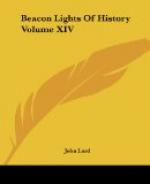The books, pamphlets, and newspaper articles on Wagner would fill a library. He has been more written about than any writers except Shakspere, Goethe, and Dante. He was also fond of writing about himself. His autobiography (extending only to 1865) has not yet been given to the public; but there are many autobiographic pages in the ten volumes of his literary works, which have been Englished by Ellis. Of great value are Wagner’s letters to Liszt and to other friends. These were utilized for the first time in “Wagner and His Works,” the most elaborate biography in the English language, by the author of the foregoing article. Shorter American and English books on Wagner have been written by Kobbe, Krehbiel, Henderson, Hueffer, Newman, &c. Of French writers Lavignac, Jullien, Mendes, Servieres, Schure, may be mentioned. Of great value are Kufferath’s monographs on the Wagner operas and Liszt’s analyses. In Germany the standard work of reference is the third edition of Glasenopp, in six volumes, four of which are now (1902) in print. Other German writers are Porges, Wolzogen, Pohl, Nohl, Tappert, Chamberlain, &c. The best histories of Modern Music in general are Langhaus’s larger work and Riemann’s “Geschichte der Musik seit Beethoven.” The best general work for reference is “Great Composers and Their Works,” edited by Professor Paine of Harvard. References to about 10,000 articles on Wagner may be found in Oesterlein’s “Katalog Einer Richard Wagner Bibliothek,” 3 vols.
JOHN RUSKIN.
1819-1900.
MODERN ART.
BY G. MERCER ADAM.
What John Ruskin has done in a prosaic, commercial, and Philistine age, in teaching the world to love and study the Beautiful, in opening to it the hidden mysteries and delights of art, and in inciting the passion for taking pleasure in and even possessing embodiments of it, that age owes to the great prose-poet and enthusiastic author of “Modern Painters.” Neither before nor since his day has literature known such a passionate and luminous exponent of Nature’s beauties, such an inculcator in men’s minds of the art of observing her ways and methods, or one who has given the world such deep insight into what constitutes the true and the beautiful in art. For these things, and for opening new worlds of instruction and delight to his age in the realm of art, heightened by the charm of his marvellous prose, we can readily pardon Ruskin for his weaknesses and perverseness,—for his dogmatisms, his fervors, and ecstasies, his exaggerations of praise and blame, and even for the missionary propagation of his often unsound economic gospel, valuable though it may be in illustrating and enforcing morality in its aesthetic aspect. Despite his enemies, and all that the critics have said contradicting his theories, Ruskin was a surprise and a revelation to his time. In not a little of all that he said and did, it is true, we cannot concur; nor can we fail to see the




